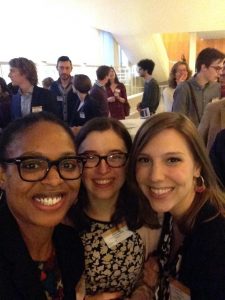
Noaquia Callahan (left), Didem Uca (middle), and Laura Lowry (right) – all PhD Candidates and 2016-2017 Fulbright U.S. Students to Germany, at the 2017 Berlin Seminar hosted by the German-American Fulbright Commission, in Berlin, Germany.
I arrived in Berlin with a set of expectations: take to the historic city like a travelista; delve deep into the European aspects of my dissertation project on African American feminist transnational activism; volunteer with student organizations at my host university; and improve my German language skills. But adjusting to life abroad took longer than expected, and opportunities to engage my university and neighborhood communities seemed out of reach. In retrospect, this was precisely the opportunity I needed to bring my creative visions for my Fulbright year to life. The first step would be to identify my objectives. The next step would be to articulate my thoughts on paper.
With a renewed spirit of infinite possibilities, I mapped out strategic steps to accomplish my goals, and used professional networks I had established in Washington, DC during my research fellowship in African American History at the German Historical Institute. For me, this meant developing as a public intellectual by connecting my scholarship on the little-known history of African American women cultural ambassadors to my community engagement work advancing diversity and inclusion in study abroad. The first step was accepting an invitation from Universität Halle to share my knowledge of African American history with German high school teachers and provide them with exercises to integrate into their curriculum focused on U.S. history, politics, and culture. By participating in the three-day workshop, I met German scholars and U.S. Embassy Berlin officials with shared interests, thus making myself more visible for future opportunities for collaboration.
My Fulbright project also helped me develop as a social entrepreneur through a company I had previously started, called the Colored Bird Institute. I founded CBI in 2014 with the hope of helping students of color apply for competitive international exchange fellowships, as well as serving as a resource to those hesitant to travel and study outside the U.S. During my Fulbright, in January 2017, I launched an initiative with a similar goal, called the Diversity International Scholarship Academy – a peer mentorship program through which I led workshops and met with students one-on-one via Skype. In learning about my work, the U.S. Embassy Berlin invited me to give a lecture on diversity in study abroad at Universität Rostock as part of the Teach About the USA program.
I also sought ways to get involved in the German-American Fulbright Commission’s activities by attending their first Fulbright Diversity Weekend and co-moderating the discussion group, “Putting My Fulbright Experience into Words,” at the annual Berlin Seminar. In Frankfurt, German Fulbrighters with migrant backgrounds shared their experiences growing up with dual cultural identities. The event not only broadened my perspective on diversity, but inspired me to consider how I can contribute to discussions on intercultural exchange for international students looking to study in the United States. This is particularly important for international students from diverse and multicultural societies, including Germany. At the Berlin Seminar, I shared that I created a website cataloguing my life abroad and contributed a blog piece, “It Must Be Schicksal (Destiny): One African American Woman’s Extraordinary Study Abroad Journey,” published by the German Fulbright Commission.
And though I kept a busy schedule, I didn’t lose focus on my academic work. My essay, “A Rare Colored Bird: Mary Church Terrell, Die Fortschritte der farbigen Frauen (the Progress of Colored Women), and the International Council of Women’s Congress in Berlin, Germany 1904,” has been accepted for publication and will be available in fall 2017 in the German Historical Institute’s Bulletin.
To prospective applicants: the Fulbright Program is not just about your academic achievements. At every round of the selection process, committee members need to be able to visualize you as an effective U.S. cultural ambassador. This means crafting compelling essays that connect the twists and turns of your intellectual biography that have made a Fulbright grant the imperative next step in your journey to greatness. To this end, I encourage you to work closely with your Fulbright Program Adviser, brainstorm your ideas with fellow applicants and Fulbright alumni, and take full advantage of the webinars and application tips provided on the Fulbright U.S. Student Program website.
As a diverse applicant, my experiences as a Fulbright U.S. Student to Germany have inspired me to push the geographical boundaries of my social enterprise to include working with organizations abroad interested in innovative methods to breaking barriers of access for minorities underrepresented in their respective international exchange programs. In our increasingly interconnected world, it is imperative to build bridges between people. Following the completion of my PhD in History at the University of Iowa in 2018, I hope to find career opportunities in the international arena in which I can contribute to cultivating transatlantic partnerships through dialogue on a range of topics while also continuing to strive towards my social entrepreneurial dreams of helping students of color apply for competitive international exchange fellowships.
You can connect with Noaquia on her website (noaquiacallahan.com) and continue following her journey on Twitter @NoaquiaCallahan.


1 Comment
thanks of article! great!